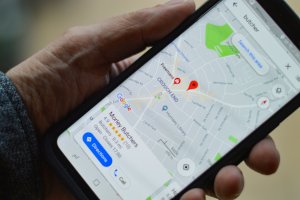Navigation Showdown: Apple Maps vs. Google Maps vs. Waze

Apple Maps, Google Maps, and Waze are all free to use and don’t include in-app purchases or intrusive ads. Each app is available on different platforms. Google Maps and Waze, both developed by Google, can be downloaded from both the Google Play Store and Apple’s App Store. Apple Maps, however, is exclusive to Apple devices and comes preinstalled on iPhones, iPads, and Apple Watches. It’s not available on Android, which means Android users are automatically excluded from using it.
For desktop users, both Google Maps and Waze offer browser versions, enabling you to plan routes on your computer and sync them to your phone. Apple Maps lacked this functionality until recently. Apple addressed this by releasing MapKit JS, allowing websites to embed Apple Maps—DuckDuckGo, for instance, now uses it for map searches. Apple is also testing a web-based beta version of its Maps app.
Best for Drivers
All three apps are capable of providing solid driving directions, but each has its own strengths. Google’s mapping services—Google Maps and Waze—benefit from a massive and detailed database. While Apple Maps had a rocky start years ago, it’s improved significantly and now competes closely with Google.
If your primary use is driving, Waze is often the preferred choice. Its user interface is designed with drivers in mind, offering bold visuals, large icons, and fewer distractions. Waze relies heavily on community input, with users reporting traffic, crashes, speed traps, and road closures. However, it lacks support for downloading offline maps—something both Google Maps and Apple Maps offer.
Best for Cyclists
While Waze is primarily for drivers, both Apple Maps and Google Maps support multiple forms of transportation. These include cycling, walking, public transport, and even ride-sharing integrations with services like Uber and Lyft.
For cyclists, Apple Maps stands out with its thoughtful user experience. It can wake the screen for each turn when navigating, making it easier to stay on track. Google Maps offers a similar function but requires manual settings to avoid screen lock. Apple also provides helpful route details like traffic lights, stop signs, and steep inclines. However, many cyclists find that Google Maps often delivers better route optimization by avoiding busy roads or excessive elevation.
User Interface Comparison
In terms of visual design, Apple Maps and Waze offer cleaner and more readable layouts compared to Google Maps. Waze is particularly easy to read, making it ideal for quick glances while driving.
Apple’s interface comes next, with clearly labeled landmarks and an intuitive layout. The app also includes useful extras like temperature and air quality data. While Apple Maps includes details like store hours and ratings, Google Maps remains the most comprehensive, covering more countries and offering advanced features like indoor maps of malls and public venues. That extra detail, however, can make Google Maps feel visually cluttered.
Both Apple Maps and Google Maps include satellite, terrain, and 3D modes. Apple’s Flyover mode, though, creates 3D diorama-style visuals of select cities, offering a visually impressive experience, even if it’s more aesthetic than functional.
For privacy-conscious users, Apple Maps is the better choice. It processes searches and directions locally on your device, with anonymized location history that resets periodically. In contrast, Google stores more user data in the cloud, though it has recently improved its privacy tools.
Newer Articles
- Spotify Takes Flight: A First Look at Its Debut on United Airlines
- Samsung Galaxy Z Fold 7 and Flip 7 Names All But Confirmed Through Leaks
- The Role of the Radio Strap in Fireground Safety

